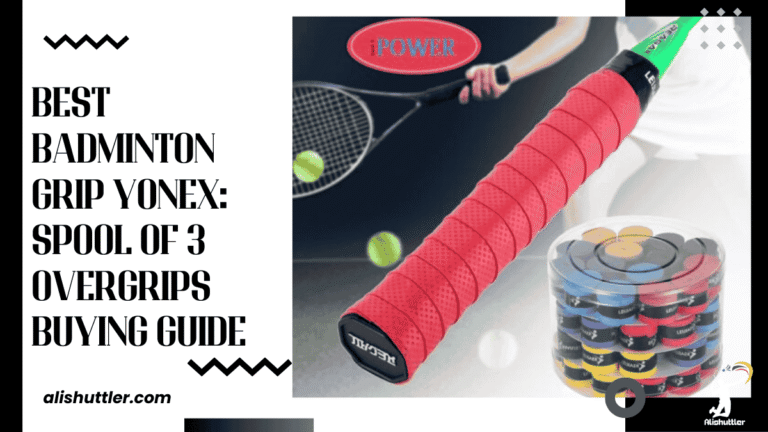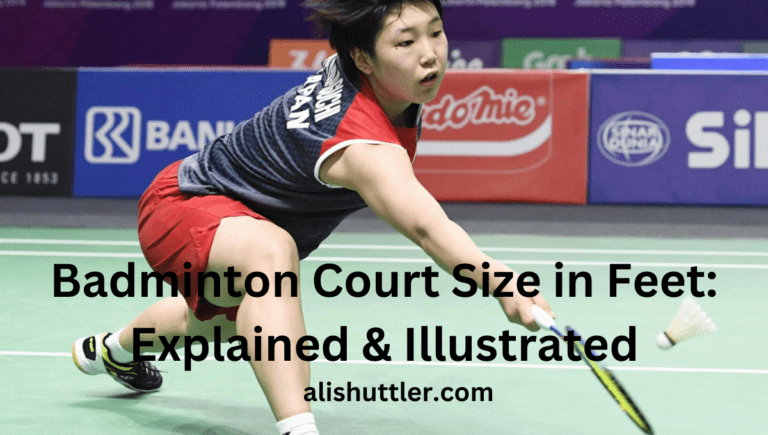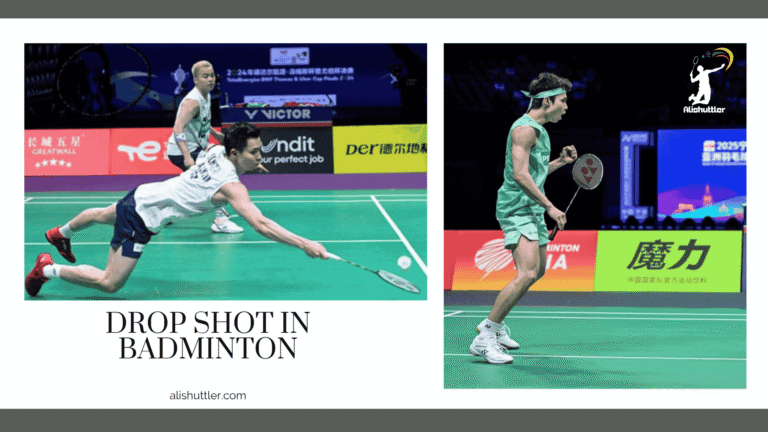Badminton racket weight means the heaviness of a racket. In the United States, it’s typically measured in ounces for player rackets. Most rackets fall somewhere in the 2.8-3.5 ounce range unstrung and without a grip.
A light racket enables fast swings and is superior in speedy net play. On the other hand, an overall heavier racket provides you with more power, which is ideal for powerful clears and smashes. The best weight just really depends on the player’s skill level, how they like to play, and what feels comfortable.
This is why racket companies usually recommend lighter rackets for beginners, who need easy-to-handle rackets, while advanced players tend to choose heavier models for more control. Being aware of the weight allows you to select a racket that is appropriate for your skill level and won’t wear out your arm.
The following sections analyze each weight class and who they’re most appropriate for.
What Is Racket Weight?

Racket weight is the total mass of a badminton racket, typically expressed in grams. It determines how a racket will play and influences how a racket feels in your hand. It’s more than just what it weighs or if it’s pretty in that color.
When choosing a racket, weight is an important consideration. Up to 15% of your decision usually comes to this. Lighter rackets are generally more maneuverable and quicker, providing more speed for quick play and control. Heavier rackets do more of the work for you by hitting harder, providing extra power and speed to shots, but can fatigue your arm more quickly.
That’s why comfort, as well as fatigue relief, are crucial factors to consider, especially if you compete in long matches or practice frequently. Adding strings, which typically weigh 3-4 grams, can even change how the racket feels.
Every player interprets weight differently. Others want the biggest racket as well as the quickest swing. Others appreciate the crisp sound of a thick frame. A racket that seems perfect to one player may feel wrong to the next. When it comes to finding a good fit, it’s all about the individual.
The “U” Weight System
The “U” Weight System classifies rackets in order of weight. Common categories are 2U (ex: 3.3–3.5 oz), 3U (3.2–3.3 oz), 4U (3–3.2 oz), 5U (2.8–3 oz), and 6U (2.5–2.8 oz). This system allows players to choose the correct rackets based on what they are looking for.
So for instance, the majority of adult men will play with 3U or 4U rackets. The “U” weight system has been in use for decades. This gives players and coaches a common language to communicate about and select rackets.
Common Racket Weight Ranges
You might find rackets as low as 2.3 oz (65 grams) and as high as 3.5 oz (100 grams). Here’s a quick guide:
- Light (5U/6U, 2.5–3 oz): Fast swings, more control, less power
- Medium (4U, 3–3.2 oz): Balance of speed and strength
- Heavy (2U/3U, 3.2–3.5 oz): More power, but may cause fatigue faster
Beginners usually go for medium weights to start with. Lighter rackets are better for doubles and fast net play. Heavier rackets are better for singles and strong overhead smashes.
Why Every Gram Counts
Every single additional gram in a racket affects swing speed, comfort, and your overall fatigue level during play. Whether it’s improving shot control from a lighter racket or reducing tension on your arm with a heavier frame.
Lighter rackets make it easier to react fast and play longer, while heavier rackets boost power but may slow you down. Choosing the ideal racket weight can result in crisper, more precise shots and an all-around improved performance on the court.
Why Racket Weight Matters Most
Here’s the thing—racket weight influences every aspect of your performance on the court. It plays a role in everything from how much zip you put on every shot to how long you can maintain that speed. The perfect weight will support effortless motion, while preventing fatigue from setting in.
In fact, it can even reduce risk of injury! The sweet spot There’s magic in the balance, with each weight range providing its unique advantages for various styles.
1. Power Versus Control
The best rackets for power, typically weighing at least 3.2 ounces to 3.5 ounces, allow players to generate more power on their smashes and clears. You can observe this in players who like to end rallies quickly by hitting aggressive, powerful shots. Conversely, lighter rackets that weigh more towards 2.8 to 3.0 ounces give players the ability to control and position the shuttle with more accuracy.
That weight gives them good response at the net. Balancing power and control is a matter of playing your game. In doubles, perhaps control is even more important for fast exchanges. In singles play, the additional weight could be an asset in achieving those deep clears.
2. Swing Speed & Agility
The overall weight of the racket affects your swing speed and ability to be agile. Lighter rackets allow more movement in your arm and wrist, an important factor for quick, agile games. Athletic players who enjoy drop shots, fast drives, or jump smashes tend to choose lighter rackets.
When demoing rackets, pay attention to how fast you can move from shot to shot.
3. Less Fatigue, Longer Play
Additionally, heavy rackets can noticeably fatigue you during longer matches. Lighter rackets reduce fatigue, allowing you to stay strong until the last rally. Competitive players or avid fans who spend hours of the week playing are more likely to choose a lighter racket for this reason.
Less fatigue leads to a sharper focus and fewer costly mistakes.
4. Lowering Injury Risk
Playing with an overly heavy racket can cause wrist or shoulder strain. Further, over time this can contribute to overuse injuries. Lighter rackets tend to be better for your joints.
Monitor your pain and discomfort levels though, when you make the switch. That might be an indication that’s the weight you should be using.
5. The Racket’s Feel
It affects how stable the racket feels when you make contact with the ball. Some like a more hefty, bulky feel when they make hard contact, and some want a more agile, quick-swinging racket for a faster game.
Again, the ideal way to gauge feel is to take a few practice swings or volleys before purchase. In the long run, your game and personal preference will guide you to the best choice.
Your Ideal Racket Weight

Selecting your ideal badminton racquet weight is ultimately a process that combines science, artistry, and instinct. The weight of a racket significantly affects your swing speed, power production, and quick reaction ability during a badminton game. Typically, this weight ranges from 2.8 to 3.1 ounces (around 80 to 89 grams), which serves as a great middle ground for many players. Finding the right racket weight often involves experimenting with different weights to discover the perfect balance for your playing style.
Beginners: Start Light
If you’re new, lighter rackets (less than 3 oz or around 75 to 85 g) make you learn better. These concepts help you swing the racket, cover the court, get to shots, and develop fundamental movements. Using a lighter racket will reduce the risk of strain or injury, which is a big deal for new players.
Find rackets that are classified as 4U (80-84g) or lighter. If possible, consider picking one up in-person to see how it feels in your hand before making a purchase.
Intermediates: Find Balance
After you’ve built up a little experience under your belt, mid-weight rackets (3.1 ounces or 85-89 grams) are a good fit. These rackets offer more power while sacrificing some of the speed. When your skills continue to develop, transitioning to a more balanced racket will allow you to generate more powerful shots without sacrificing your agility.
Brands typically label these as 3U rackets. Good intermediate rackets are Yonex Astrox 77 or Victor Brave Sword 12.
Advanced: Fine-Tune Weight
Advanced players may try various weights to suit their game. Other players will need heavier rackets, maybe even over 7 ounces (200 grams) for more explosive drives. Some players choose a lighter racket to help them play quicker.
Training rackets heavier than 3.5 ounces (100g+) are good for strength training. Fine-tune is the name of the game—tiny adjustments can have a major impact on playability.
Match Your Playing Style
When playing singles, a lighter racket can be crucial for extended rallies. On the other hand, doubles players like heavier rackets for quicker, crisper shots. Your technique and most-played shots—such as smashes or net play—dictate your choice.
Naturally, singles players would be more likely to choose a 4U for quick swing speeds, but we see doubles pairs use the 3U for added firepower.
Decoding Racket Weight Charts
Racket weight charts are essential for badminton players to select the right badminton racquet by clearly displaying weight classes and facilitating simple side-by-side comparisons. These charts utilize a “U” system, where a higher number signifies a lighter badminton racket. For instance, a 4U racket, weighing 85–91 grams, is lighter than a 3U, which weighs 81–87 grams. Understanding badminton racket weights is crucial for optimal performance.
Core racket weight refers to the weight without strings. Typically, badminton racquets weigh between 70–130 grams, with strings adding an additional 3–4 grams. Lightweight rackets, ranging from 70–95 grams, provide enhanced maneuverability and faster swing speeds, while heavier options, between 110–130 grams, deliver more power.
Some brands, such as Li Ning, employ a “W” system to categorize their badminton equipment by weight, ensuring that players can easily navigate their racket selection for the best fit.
| Weight Class | Weight (grams) | Description | Ideal For |
|---|---|---|---|
| 1U | 95–99 g | Heaviest rackets | Strong players who prefer power and stability |
| 2U | 90–94 g | Heavy rackets | Advanced players focusing on power |
| 3U | 85–89 g | Medium weight (most common) | Balanced for both power and control |
| 4U | 80–84 g | Lightweight | Intermediate players; faster swings |
| 5U | 75–79 g | Very lightweight | Beginners or players valuing speed & maneuverability |
| 6U | 70–74 g | Ultra lightweight | Defensive players or those with quick reflexes |
💡 Quick Tips
- Heavier rackets (1U–2U): Offer more power and stability, suitable for singles.
- Lighter rackets (4U–6U): Offer faster swings and better control, often preferred in doubles.
- 3U/4U are the most popular choices for a balance of speed and power.
Light Rackets: Speed
Light rackets allow speedy players to move quickly and change direction seamlessly. They’re great for doubles play, lightning fast net kills and quick defensive shots. Rapid hands and keen reflexes really shine with a 4U or 5U racket.
These rackets will work great for players who love to push the pace! Popular light rackets include:
- Yonex Nanoray 10F: lightweight, easy control
- Victor Brave Sword 12: quick handling, slim frame
- Li Ning Windstorm 72: ultralight, very maneuverable
Medium Rackets: Versatile
Medium-weight rackets (approximately 95–110 grams) are versatile and cater to a wide range of playing styles. They have a good blend of power and control.
This versatility makes them a favorite choice for all-around players who balance aggression and control. This makes them a favorite among the majority of recreational and club players who appreciate their adaptability on court.
Heavy Rackets: Power
Heavy rackets are ideal for the big hitters out there. They provide additional power on smashes and clears. Whether in singles matches or power shots from the backcourt, these rackets perform.
Examples include:
- Yonex Voltric 0.7DG: solid build, high power
- Carlton Powerblade 8700: heavy frame, strong smashes
- Victor Hypernano X900: sturdy, great for drives
Weight Isn’t Everything

Racket weight is the most commonly cited factor by all players as the most important thing to determine your level of play! Real talk, though—for all the hysteria over weight, it’s not the only thing we should be concerned about. Balance, stiffness and the overall design go a long way, sometimes further.
A change of two grams in weight will likely not be felt within your gameplay. Like that, a two-millimeter change in center of gravity rarely does the trick. Most consumers overlook the way these few measly numbers combine with other specs to determine how a racket feels in their hand.
Racket Balance Impact
Balance explains where the weight is located—in the head, evenly, or more towards your hand. This balance affects how a racket moves through the air, its swing weight, and how maneuverable it is. Head-heavy rackets hit harder right out of the box!
They can often be intimidating to make quick progress on. Conversely, even-balanced rackets are best for people who want a combination of speed and power. Other players like an overall lighter frame with a more head-heavy balance for speedy reactions.
While some prefer a little extra weight down low for more consistent maneuverability. Test it out. While specs are important, make sure to see how the racket feels in your hand before purchasing.
Shaft Flex Connection
The shaft’s flex impacts the feel and flight of every shot. Shaft flex aids fast, snappy swings benefit from stiffer shafts, while slower and smoother swings perform best with more flexible shafts. Flex is one of the factors that influences shot power and control.
Experiment with various shaft flexes, because what’s best is usually a matter of personal preference.
Materials Affect Weight
Materials such as graphite significantly lower the weight of badminton racquets while maintaining strength. While these added durability materials can weigh you down, today’s badminton racket design combines carbon, resin, and sometimes metal alloys to achieve a lightness, strength, and feel that allows for optimal performance.
Weight & String Tension
String tension plays a part in racket weight as well. Tighter strings provide more control, but require more muscle to play aggressively, whereas looser strings help generate pop.
Combine your string tension with your racket’s weight and balance to get optimal performance.
Pro Tips: Weight Nuances
Racket weight has a huge influence on your style of play in badminton. Even minor adjustments in weight can have a drastic effect on your response time and output. They can move the shuttle’s landing target by up to a half yard!
Ready for singles? In singles players, heavier rackets are the norm, typically around 3U, or approximately 3.0-3.1 ounces. This seemingly innocuous decision makes them much more powerful and stable.
For doubles players, it’s common to go lighter—4U rackets (around 2.8-3 ounces)—for quicker swings at the net. Eventually, your personal requirements may change as you experiment with various grips, shots or even travel to different leagues.
Custom Weighting Insights
Some people are looking to change it further. Aftermarket modifications, like adding lead tape or re-gripping, can affect balance and overall weight.
Adding weight at the handle increases control, while adding it near the head increases power. If you’re just getting started, a badminton fitter in your local area will be able to assist you in getting the most optimum setup.
Gradually make incremental adjustments, monitor the results over the course of multiple games, and find what works best for you. This interactive approach ensures you discover a build that suits your playstyle.
New Tech: Light & Strong
Modern rackets are mostly made from carbon fiber or other similar durable, lightweight materials. These new rackets retain the power without the heft making them easier on your arm over the course of long sets.
Brands continue to release models such as Yonex’s astrox lightweight model or Victor’s ultralight series that combine speed with strength. These improvements allow everyone from the new players to the serious contributors to experience more play without the additional weight.
My Advice: Experiment!
My Recommendation: Experimenting is important. Tip #4 Take notes.
Lastly, bring a notebook written down how each racket feels and plays during actual match play. Your ideal fit will evolve as your skill level advances, so continue to test over time.
Conclusion
Choosing the appropriate badminton racket weight will prepare you to play your absolute best. Light rackets swing quickly to enable fast, speedy shots. The advantage of heavy rackets is the power of the smashes and the feel. Whether players in LA studios, community courts or campuses, benefits are tangible. They do this by playing with a racket that complements their style of play. Just a few ounces one way or the other can change your ability to control the racket and swing speed.
Charts are useful, but nothing can replace physically testing rackets yourself. Watch for grip comfort and a balance that feels appropriate. Even small changes in weight can translate to reduced wrist soreness or better shot consistency. So test a few out before you commit to an expensive purchase. Have your own ideas or favorite rackets. Leave a question or suggestion in the comments and trade pointers with the TRInnerCity crew.
Frequently Asked Questions
What is the ideal badminton racket weight for beginners?
The sweet spot for most beginners is a light badminton racket that weighs between 3.2 and 3.5 ounces. This racket weight offers great maneuverability and swing speed, making it easy to control during the learning phase.
How does racket weight affect my badminton game?
When it comes to speed and quick reactions, a light badminton racket is definitely beneficial. However, a heavy badminton racket will provide more power, requiring more arm strength to produce it.
Can a heavy racket cause injuries?
Yes. If you use a heavy badminton racket that’s too cumbersome, you risk injuring your wrist, elbow, and shoulder from added stress, especially in extended matches.
How do I know if my racket is too light or too heavy?
If you notice you have difficulty creating power, then your light badminton racket might be too light. If you find your arm is fatiguing or getting sore over time, your heavy badminton racket may be too heavy.
Are there different weight categories for badminton rackets in the U.S.?
Yes. Typically, most badminton racquets in the U.S. will be marked with a 3U (3.2–3.4 oz) or 4U (3.0–3.2 oz), so always check the badminton racket weights before purchasing.
Does racket weight affect doubles and singles play differently?
Yes. Doubles players might benefit more from light badminton rackets to allow for faster reflexes, while singles players might prefer a bit heavier badminton racquets to add extra power in their shots.
Can I adjust the weight of my badminton racket?
The best way to increase your badminton racquet’s weight is to add grip tape or lead tape, but extreme modifications can disrupt the racket’s balance and feel.






